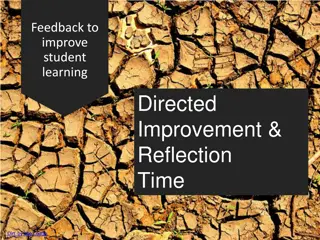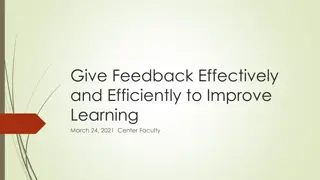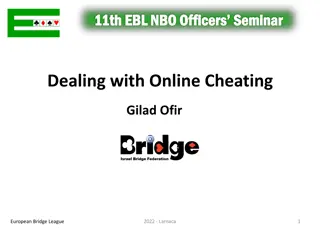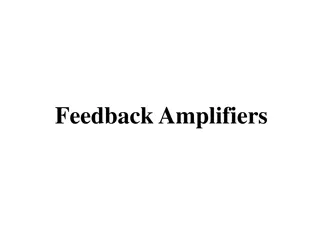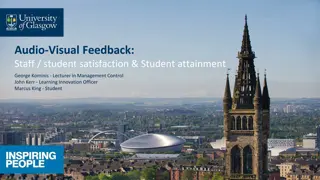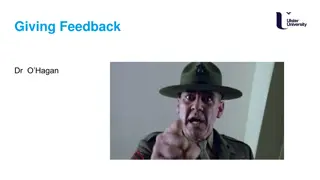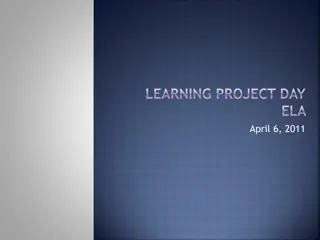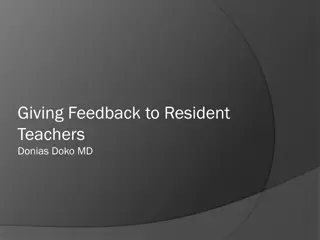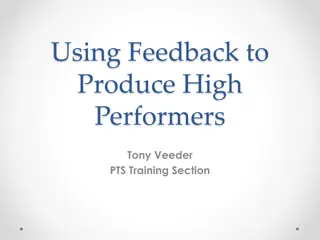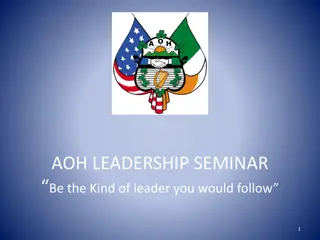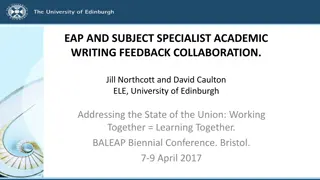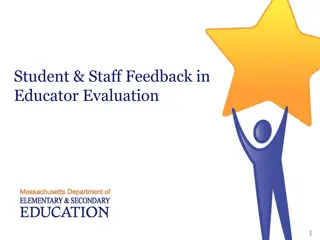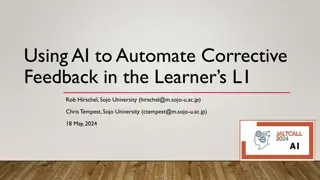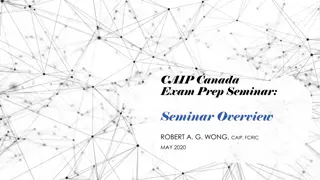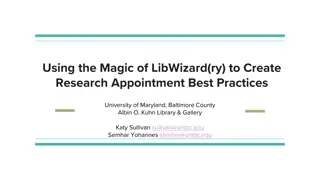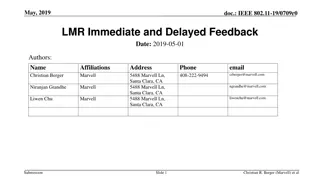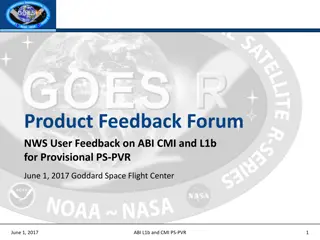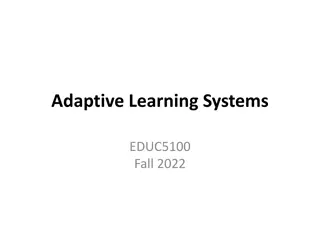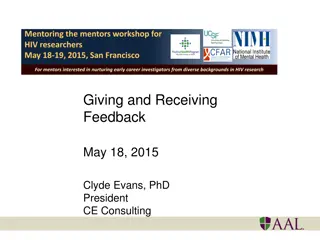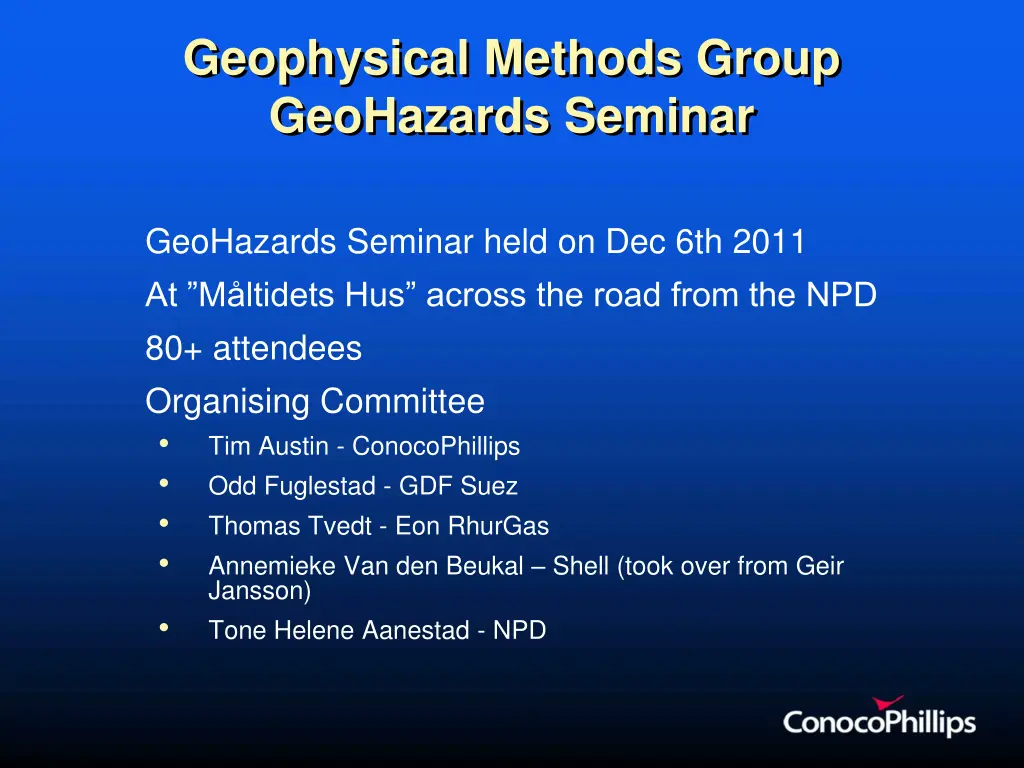
GeoHazards Seminar Insights
Gain insights into the Geophysical Methods Group's GeoHazards Seminar held in 2011, featuring industry experts discussing geohazard assessments, seismic techniques, and case studies. Attendees praised the program and highlighted potential for follow-up projects.
Download Presentation

Please find below an Image/Link to download the presentation.
The content on the website is provided AS IS for your information and personal use only. It may not be sold, licensed, or shared on other websites without obtaining consent from the author. If you encounter any issues during the download, it is possible that the publisher has removed the file from their server.
You are allowed to download the files provided on this website for personal or commercial use, subject to the condition that they are used lawfully. All files are the property of their respective owners.
The content on the website is provided AS IS for your information and personal use only. It may not be sold, licensed, or shared on other websites without obtaining consent from the author.
E N D
Presentation Transcript
Geophysical Methods Group GeoHazards Seminar GeoHazards Seminar held on Dec 6th 2011 At M ltidets Hus across the road from the NPD 80+ attendees Organising Committee Tim Austin - ConocoPhillips Odd Fuglestad - GDF Suez Thomas Tvedt - Eon RhurGas Annemieke Van den Beukal Shell (took over from Geir Jansson) Tone Helene Aanestad - NPD
Workshop Progam - morning Introduction: 08:30 08:40: Introduction and HSE 08:40 09:00: Setting the scene, Fritjov Riis, NPD 09:00 09:20: What is a GeoHazard A drilling perspective, Terje Skar ,ConocoPhillips Acquisition and Processing Technology: 09:20 09:40: Site Survey Geophysical Acquisition A recent history and an idealized future, Gavin Douglas, Fugro Geoconsulting 09:40 10:00: High resolution PCable 3D seismic acquisition from shallow to deep water in shallow gas hydrate areas. Stefan Buenz, UiT 10:00 10:30: Break and poster display 10:30 10:50: Integrated solutions for Geohazard surveys. Robert Soubaras, Yves Lafet, Shuki Ronen*, Bob Dowle, Dominique Boitier, Roar Nygaard, CGGVeritas 10:50 11:10: Ghost-free seismic acquisition a step change in data resolution and interpretability, Per Eivind Dhelie, PGS 11:10 11:30: Processing of high resolution seismic data, Ian Stennett, Gardline 11:30 11:50: Advances in 2D and 3D GeoHazard Processing, Andy Cowlard, Fugro Seismic Imaging 11:50 12:10: 3D Hi-res seismic in deep water. Best practices Floris Striijbos or Rian de Jong, Shell
Workshop Progam - afternoon Analysis and case studies: 13:30 13:50: and careful consideration, Michael Clare and Stephen Thomas, Fugro Geoconsulting 13:50 14:10: Submarine landslides offshore Norway summary of observations and implications. Jan Sverre Laberg, UiT Integrated Geohazard assessment The case for correlation, calibration 14:10 14:30: Break and poster display 14:30 - 14:50: Geohazard investigations using seismic techniques current approaches and applications, Richard Orren and Francis Buckley, Senergy 14:50 15:10: Limitations in HR2D seismic: not understood then and not understood now, Karen Ware, Andy Malone and RPS Energy Geohazards Group 15:10 15:40: Statoil s experience with geohazards evaluation on the NCS, Dag Lundquist, Statoil 15:40 15:50: Summary and wrap-up.
Feedback Lot of positive feedback on the day Questionaire response from 17 attendees All said Seminar met expectations All thought it was a good program More oil company experience presentations Venue and timing were good Some potential for follow-up projects
Did the seminar meet your expectations? I found it very interesting, and in that aspect it did meet my expectations. Some of the talks perhaps were trying to put too much into a 20 minute slot and in this aspect perhaps could have been focused a bit more on a sub-topic of what was being spoken about. Seminar contained some interesting presentations but a bit too much marketing from service companies. The seminar did meet my expectations and contained a good mix of presentations, of particular interest were the seismic capabilities and new technologies employed by some of the companies. Yes (indeed it exceeded expectations and the quality of the presentations was excellent and well focussed) Yes, it covered the expectations I had, but I wish there had been more presentations on the geohazard itself rather than an update on data acquisition and (re-)processing. More on shallow gas studies state-of-the-art for example. As a Survey Company, we were interested in hearing what competitors and clients are up to but as geologist, I'd also have enjoyed some discussions on geological rather than geophysical issues. The seminar partly met my expectations. Yes, it was a very good program. The seminar met my expectations. There was a good range of topics. Yes, it was very good.
Was there anything we should add or take away from the program? Maybe more (1 or 2) real cases, as the one presented by a petroleum company regarding APA 2011 I would suggest more real examples from oil companies on how they approach assessing shallow geohazards. The early presentations from npd and drilling engineers gave good context to the need for rigorous geohazards work. This area could be expanded, or the delegate list include more drilling engineers to gain their input and feedback on geohazard assessment. More time for questions/discussion following each of the presentations would have been useful. Add: precision on potential poster session. It was not really clear and we would have been happy to prepare one as CGG did. In general, the presentations given by Oil companies were better than presentations from contractors. Some presentations were too commercial like the ones from CGGVeritas or PGS. Oil companies sharing their experience on the way they handle geohazards has more value. In my view it would be beneficial to add more case studies, true stories regarding prognosis versus actual drilling observations and how to tackle it. I think the variety of subjects was necessary. For example, some people work on spud-can penetration in shallow water, while others work on the risk of landslides in deep water. I would not have changed anything. It would have benefitted from more time for discussions. Presentation of the experience base from the NCS, and recommendations for possible improvements /simplifications resulting from this. No, I think the mix were great Perhaps a panel discussion at the end?
Was the venue and timing satisfactory? My only negative really was the scrum that ensured at the end of the day to get a taxi it perhaps would have been good if a few had been pre-booked, or if perhaps at lunch a quick poll had been taken to ascertain approximately how many taxis would be needed. The venue was good, and the lunch / refreshments were good also. Venue and timing was fine. Warm lunch would have been nice. The venue was good, though the time for questions was often short due to the full schedule Venue was very good and entirely suitable for the seminar. However; if you do another, I think you might need to use a larger lecture theatre as I suspect it will attract a greater number of attendees. My only complaint is the time taken to get a taxi back into town after the event. After the seminar, the lady on reception booked lots of taxis, some going to the airport and some going into the city centre but we had to wait a long time for all of these to arrive, though this was possibly due to the weather? The only problem is to be able keep the speakers within their time slot (as usual)... Venue and timing were perfect Yes, venue was good, maybe allow for 5 minutes changing speaker/question session The venue was OK and the whole event was kept within 8 hours duration. I was content with it. Yes, satisfactory. Prefer the NPD auditorium however Yes but I would like better lunch! Yes. Potential for a seminar dinner and 2.nd day up till lunch
Do you feel there are any of the Geohazard topics that could mature into a FORCE project or further specific seminar? More information on geohazards related to coral reefs and relations with the NPD Was intrigued by the examples presented by Statoil of unpredicted shallow gas no explanation for these events was presented. Do we need to screen pre-stack more rigorously for a range of AVO classes and understand the shallow rock physics better to understand whether seismically transparent gas pockets are possible? The most interesting aspect of the seminar was the application of new and 3D seismic technologies for geohazards work, as opposed to traditional stand alone 2D surveys. A project investigating how these can be best implemented, technically, for geohazard work as well as reservoir imaging could lead to significant improvements in geohazard assessments Geologist-oriented seminar, focused on hazards sl: geohazards (shallow gas, water flow...) but also drilling hazard related to stratigraphy for example. Yes, as an outcome of the seminar, my feeling is that today s legislation with 2D required site survey could be reviewed to allow for 3D exploration survey or 3D site surveys to be used as an alternative to the 2D (which was proven not to be very liable) Possibly: Deep water, geotechncal and geophysical interation Studies, Interaction with Drillers on expectations of Geohazard work. The talk from the drilling engineer was very interesting and interaction with end users of the Geohazard anaysis is usually quite limited. Maybe further focus on the possibility of integrating/using 3D surveys for Geohazards (also in shallower water). Also integrate w. other types of surveys (e.g. EM). Project to map areas of specific geohazards on the Norwegian continental shelf. The JIP Geohazard initiated by ACONA (poster presentation) is something that the seminar should follow closely, it should have been part of the presentations I think many of the topics could easily be turned into FORCE project. Many new techniques were presented at the seminar and I think it would be wise to review the presentations further. Data management and reporting issues.

